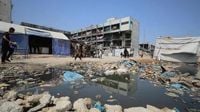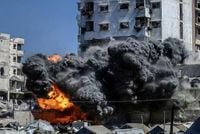In the early hours of September 13, 2025, the Gaza Strip was once again plunged into chaos as Israeli airstrikes and artillery fire tore through densely populated neighborhoods, leaving devastation in their wake. According to Al Jazeera and the Palestinian Chronicle, at least 65 Palestinians were killed by Israeli fire since dawn, with the majority of casualties—48—occurring in Gaza City and the northern part of the Strip. The relentless assault destroyed a residential tower, multiple shelters, and forced thousands more to flee for their lives, even as so-called safe zones in southern Gaza offered little reprieve from the violence.
Despite evacuation orders and continuous bombardment, more than 1.3 million Palestinians—including 350,000 children—remain trapped in besieged Gaza City and the north. The United Nations Relief and Works Agency (UNRWA) revealed that over 86% of Gaza City is now under evacuation orders, with entire neighborhoods in Gaza and Jabaliya being forcibly emptied. For many, the choice is stark: risk death from bombs or starvation, or risk death trying to escape.
Humanitarian conditions in Gaza have reached catastrophic levels. The Gaza Health Ministry reported that, since October 7, 2023, Israeli military operations have killed 64,803 Palestinians and injured 164,264 others, the majority of whom are women and children. The toll is not just due to violence—starvation has claimed 420 lives, including 145 children, as severe restrictions on aid and the destruction of infrastructure have turned food and medical supplies into rare commodities. Seven more Palestinians, including two children, died from starvation and malnutrition in the 24 hours preceding September 13, according to the Health Ministry.
On the diplomatic front, the United Nations General Assembly overwhelmingly approved a resolution on September 12, 2025, calling for "concrete, time-bound, and irreversible steps" toward a two-state solution. The measure passed with 142 votes in favor, 10 against, and 12 abstentions—a clear indication of the global community’s impatience with the status quo. Yet, the violence on the ground shows little sign of abating.
Amid this turmoil, a particularly poignant moment unfolded in Doha, Qatar. Dr. Khalil al-Hayya, a senior leader of Hamas in Gaza and head of its negotiating delegation, participated in funeral prayers for his son and other members of the movement killed in an Israeli strike on the Qatari capital. Hamas confirmed that the ceremony took place "following special security arrangements in the State of Qatar." The attack on Doha has sparked outrage across the region and heightened fears that the conflict could spill beyond Gaza’s borders.
Back in Gaza, the destruction continued unabated. Israeli warplanes bombed Al-Noor Tower in Tel al-Hawa, southwest Gaza City, after issuing evacuation orders. Elsewhere, artillery shelled the Al-Tuffah and Al-Yarmouk areas, while airstrikes targeted the Al-Amal neighborhood in Khan Yunis, killing three and wounding 16. In Al-Shati refugee camp, two UNRWA schools sheltering displaced Palestinians were struck, further endangering civilians who had nowhere left to run.
The violence has not been confined to Gaza. In the occupied West Bank, Israeli forces stormed the Al-Arroub refugee camp north of Hebron and escalated raids and mass arrests across the region, detaining more than 1,500 people in Tulkarm and attacking refugee camps under a months-long blockade. The Palestinian Red Crescent reported receiving a Palestinian man who had been beaten by the Israeli army in Wadi Burqin, while a 16-year-old boy was shot in Qalandiya refugee camp near Jerusalem.
Efforts to break the siege of Gaza have taken to the seas, with the first ship of the Global Sumud Flotilla departing from Bizerte, Tunisia, on its way to the embattled enclave. The flotilla, facing difficult weather conditions and political obstacles, aims to deliver desperately needed aid and draw international attention to the ongoing blockade.
Meanwhile, the conflict’s reverberations are being felt far beyond the Middle East. Protests demanding an end to the war and sanctions against Israel erupted from Berlin to Rabat, with tens of thousands marching in solidarity with Palestinians. In Tel Aviv, thousands of Israelis demonstrated for a prisoner exchange deal and an end to the war, signaling growing domestic fatigue with the conflict. A Maariv poll found that 51% of Israelis now favor ending the war and securing the release of captives, even if Hamas remains in power in Gaza.
Yet, the Israeli government remains undeterred. Defense Minister Yisrael Katz declared, "the hurricane continues to strike Gaza," boasting of the destruction of Al-Noor Tower and the displacement of residents. He claimed the assault would pave the way for a full-scale ground operation to "subdue Hamas." Israeli security officials, however, have warned Prime Minister Benjamin Netanyahu that the operation in Gaza City could drag on for months without achieving its objectives and may even result in the deaths of hostages. Despite these warnings, Netanyahu has insisted on pressing forward.
International actors are also being drawn into the fray. The Yemeni Ansarallah movement announced missile strikes on Israeli military positions in support of Palestinians under siege in Gaza, vowing that operations would continue. The United States, for its part, has made clear that it wants all hostages in Gaza released at once, with Secretary of State Marco Rubio warning of possible Israeli retaliation against countries recognizing Palestine and promising to consult with Israeli officials about their future plans.
The humanitarian crisis has prompted dire warnings from aid agencies. The UNRWA Commissioner stated that the famine in Gaza is "caused by severe restrictions on aid, destruction of infrastructure, and repeated attacks on humanitarian operations." He lamented, "I have never before witnessed such blatant disregard for the protected status of humanitarian workers and facilities." UNICEF added that more than 10,000 children in Gaza have been diagnosed with acute malnutrition in just the past two months.
For those still in Gaza, the daily reality is one of terror and uncertainty. Palestinians are documenting and sharing harrowing scenes from Israeli airstrikes and raids, with entire families wiped out and neighborhoods reduced to rubble. Many are forced to risk their lives simply to access aid, as Israeli forces have opened fire on civilians waiting for food near the Netzarim Corridor and in central Gaza.
In the words of a Hamas statement, "What is happening in Tulkarm with mass arrests reflects the criminal face of the entity, which knows nothing but killing, torture, and abuse. The aggression and arrests in Tulkarm and all governorates of the West Bank will not break the will of our people nor bring security to the occupation." While such rhetoric may be expected, the underlying reality is that the violence and suffering show no sign of ending soon.
As the world watches, the people of Gaza remain caught in a cycle of destruction and deprivation, their fate hanging in the balance as leaders on all sides dig in their heels. The coming months will test the resolve not just of those under siege, but of the international community itself.


